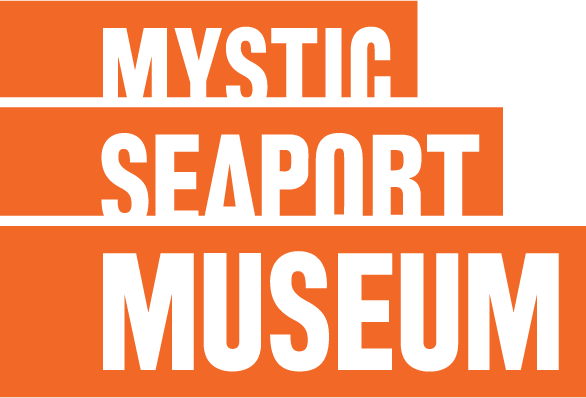Category: News
Read the latest Mystic Seaport news.

Mystic Seaport will hold its annual Antique & Classic Boat Parade on the Mystic River beginning at 11:45 a.m., Sunday, July 23. The boats should begin passing through the Mystic River bascule bridge in downtown Mystic at about noon.
The new start time is 30 minutes earlier than previously announced to accommodate the bridge opening schedules
The name and particulars of each boat will be announced at a public address station on the shore at Mystic River Park as it passes through the bascule bridge. The boats then make their way in a procession down river to the village of Noank.
The parade is the conclusion of the Museum’s Antique & Classic Boat Rendezvous weekend, which showcases high-quality antique vessels, including cruisers, sailboats, and runabouts. Approximately 50 classic vessels will gather along the museum’s waterfront. Visitors are invited to see the displayed vessels Saturday from 9 a.m. to 5 p.m. and Sunday 9 a.m. to 11:45 a.m. An awards competition will recognize excellence in restoration, authenticity, and workmanship.
To celebrate the 85th anniversary of the launching of the museum’s schooner Brilliant, the Rendezvous will highlight boats designed by the naval architecture firm Sparkman & Stephens. Brilliant was design #12, one of the earliest of co-founder Olin Stephen’s designs. She was launched in 1932 at the Henry B. Nevins, Inc. yard at City Island, N.Y. As one of the longest-running sail training programs in the country, she has carried more than 10,000 students on cruises throughout New England and beyond.
The old adage ‘where there’s smoke, there’s fire’ was both true and appropriate today at Mystic Seaport, when the first fire was lit in the steamboat Sabino’s new boiler.
A crowd of Mystic Seaport administrators, shipwrights and other interested parties gathered as a wood fire was built and then lit. Others stood on the dock in the Museum’s shipyard or on the Sabino’s bow to watch the smokestack for the first sign of smoke. There was a cheer when the first puff appeared.
Jason Cabral, Sabino’s lead engineer, said the fire was the first step in making the boiler fully operational. Chemicals that are added to the boiler tubes to fight corrosion and scaling needed to be heated in the water to set. It is a similar process to “seasoning” a new cast iron skillet. The Friday fire was to condition the boiler tubes with the chemicals.
“It took off beautifully and everything is doing what it’s supposed to do,” Cabral said of the first firing of the boiler. “We can already hear water circulating through it. It’s a big day, a big day for me at least, because I’ve been waiting two-and-a-half years for this. I’m really excited about getting her running.”
Sabino has been in the Museum’s Henry B. duPont Preservation Shipyard since late 2014 for an extensive restoration. Museum shipwrights addressed a number of issues around the vessel, including reframing much of the stern, replacing the keel bolts, installing new planking and decking, and restoring portions of the superstructure. In addition, numerous mechanical and systems upgrades were carried out. On June 14, a new boiler and water tank were installed. The engine and canopy were installed on June 16, followed by the installation of the stack.
Next week, Cabral said, a coal fire will be lit and there will be two important tests conducted. The first – a hydro test – requires the boiler to be filled to the top with water and “we use a pump to pressurize it and make sure all the fittings are correct and don’t leak.” The second test is of the boiler’s safety valves. “In that test we bring the boiler up to full pressure, to where the safety valves let off, and the Coast Guard makes sure they are operational,” Cabral said.
Sabino will return to regular operation beginning August 2, with one 30-minute cruise to start each day followed by two downriver cruises.
“It’s like the heartbeat of Mystic Seaport is returning,” said Dave Childs, Sabino captain.
Dedication of Vietor Garden
The dragonflies and honey bees were having a grand time in The Vietor Garden on Monday afternoon, flitting and buzzing among the daylilies, asters, and bee balm. They were so busy that they did not notice the gathering of a small group of people around the edges of the garden on this beautiful July day.
The dedication of the new Vietor Garden, given to Mystic Seaport in memory of Anna Glenn Butler and Alexander Orr Vietor by their family, under a cloudless sky, was the final piece in the Museum’s redevelopment of the north end of its grounds.
The ceremony began just after noon, and as the last of the Greenmanville Church’s 12 chimes on the hour died away, Museum President Steve White stood to speak.
“If you heard just now the church clock’s chimes, those have been a long time coming,” White said. “Thanks to the efforts of some volunteers and our staff those chimes have been restored. Those, and the dedication of this garden, are the final pieces to bring together this entire landscape. The Vietor Garden is the last piece to create a gorgeous place to be.”
The reworking of the north end into the McGraw Quadrangle was part of a longtime vision for Mystic Seaport, White noted. Anna and Alexander Vietor also had a vision for the Museum.
“Anna Glenn was an extraordinary philanthropist and we were so lucky that Mystic Seaport was a place she decided was deserving of support. Alexander spent 25 years as a trustee, and with the exception of one or two years, for 60 years we have had Vietors involved with our board. Alexander was very involved with the concept and construction of the G.W. Blunt Library in 1964, and Alexander and Anna were very involved with the creation of what has become our PILOTS program.”
In 1981, when Alexander passed away, he gifted his extensive logs and manuscripts collection to the Museum. Since then, Mystic Seaport has grown the collection from 10,000 volumes and 68,000 manuscripts to more than 75,000 volumes and 1 million manuscripts.
The garden was given by the Vietor children: David, Richard, Louise, Pauline, Alexander, and Martha. David Vietor spoke briefly at the dedication, expressing gratitude to Mystic Seaport for the opportunity to create the garden for the area, as horticulture was his mother’s passion. “She loved that gardens are continually renewing themselves, that cycle of life,” he said.
The garden was designed by Brian Kent of Kent + Frost Landscape Architecture of Mystic. Kent said the garden was planned to be sustainable, with plant combinations that replicate the natural landscape, showcasing Mrs. Vietor’s favorite colors, in a way that would be sustainable over the long term without the use of pesticides, fertilizers, and little weeding. He jokingly invited the guests to come back in a year, saying that a new garden is a lot like “a 13-year-old boy. Lots of arms and legs and a big head and it looks like nothing goes together.”
Julia Jankowski, garden supervisor for the Museum, said that while there are 18 varieties of plants in the garden, there are more than 1,000 actual plants. It took two days, a squad of 12 volunteers, plus staff to plant the garden in the spring.
Mrs. Vietor’s Garden Plant List:
Veronicastrum virginicum – Culver’s Root
Aster oblongifolius ‘Raydon’s Favorite’- Aromatic Aster
Erigeron pulchellus – Robin’s Plantain
Hemerocallis x ‘Ice Carnival’- Daylily
Meehania cordata – Meehan’s Mint
Salvia x sylvestris ‘May Night’- Sage
Sesleria autumnalis – Autumn Moor Grass
Symphyotrichum ericoides ‘Snow Flurry’- Heath Aster
Waldsteinia fragarioides – Appalachian Barren Strawberry
Quercus bicolorr – Swamp White Oak
Panicum virgatum ‘Heavy Metal’- Blue Switch Grass
Agastache foeniculum – Blue Giant Hyssop
Amsonia hubrichtii – Arkansas Blue Star
Baptisia australis – Blue False Indigo
Eryngium x ‘Big Blue’- Sea Holly
Liatrus spicata – Gayfeather
Monarda bradburiana – Eastern Bee Balm
Sporobolus heterolepis – Prairie Dropseed

The National Park Service announced today that Mystic Seaport is the recipient of a National Maritime Heritage Grant.
The Museum is one of 27 recipients in 13 states and the District of Columbia who will collectively receive $1,752,073 in grant awards. In partnership with the U.S. Department of Transportation’s Maritime Administration (MARAD), the National Park Service awarded grants for projects that teach about and preserve sites and objects related to our nation’s maritime history.
“Protecting our nation’s maritime history is an important part of the National Park Service’s mission to share America’s story,” said Acting National Park Service Director Michael T. Reynolds. “These grants will support efforts to conserve important parts of our maritime history and educate students of all ages.”
Mystic Seaport was awarded $49,959 to support development of “From Clippers to Containers: The Benjamin F. Packard and the History of U.S. Deepwater Cargo Transport,” a long-term exhibition that will deliver to a broad public audience important historic content about the changes in the maritime cargo trades from the mid-19th century to the present.
The centerpiece of this exhibit will be the recently reinstalled cabin from the Down-Easter Benjamin F. Packard which Mystic Seaport salvaged in 1939 before the ship was scuttled. The Packard ship’s cabin is a favorite with visitors because of the immersive experience: “beyond-the-ropes” access allows visitors to walk into the dining area, parlor, and captain’s stateroom, an ornate Gilded Age setting complete with velvet settees and burled wood panels. This unique artifact is an ideal vehicle to frame the history of American merchant vessels.
In addition to the compelling story of the Packard, the exhibition will focus on the evolution of American cargo handling and deep water trade using examples of various vessel types to illustrate the changes in society and technology that occurred over time. “From Clippers to Containers” will use interactive technology as well as ship models, period paintings, photos, and other artifacts to illustrate these stories.
The National Maritime Heritage Program Grant awards are made possible through a partnership between the two federal agencies, which both share a commitment to maritime heritage preservation and education. They are funded through recycling of vessels from the MARAD’s National Defense Reserve Fleet. The grant program supports a broad range of maritime education and preservation projects, without expending tax dollars, while ensuring that the vessels are dismantled in an environmentally sound manner.
For a complete list of the recipients and the award amounts please see the National Park Service press release.
Pinhead Institute Intern
Rosenfeld: Guy Lombardo as Speed Racer
WoodenBoat Honors Hewson

Retired Mystic Seaport Vice President Dana Hewson will receive a Lifetime Achievement Award at this weekend’s 26th annual WoodenBoat Show.
Hewson, the Seaport’s vice president for watercraft preservation and programs and Clark Senior Curator, retired in April after 39 years. He was in charge of the museum’s collection of more than 550 boats and helped oversee the restoration of the Charles W. Morgan, Roann and construction of the replica of the Amistad.
“The WoodenBoat Show team has worked closely with Dana and his staff over the years producing the shows at Mystic Seaport. We are thrilled to honor and thank him for his dedication to Mystic Seaport and his support of the WoodenBoat Show,” said Jim Miller, president of WoodenBoat Publications.
Hewson will be honored at a Saturday dinner held in conjunction with the show. Also set to be honored for lifetime achievement that night is Boatbuilder George Luzier. He has built hundreds of boats, ranging from daysailers to outboard skiffs to cruising sailboats. Several of his boats are cherished by longtime owners, including the 39′ 1967 John Alden-designed ketch Horizon of Castine, Maine.
The WoodenBoat Show is presented by WoodenBoat Magazine and attracts about 13,000 wooden boat enthusiasts each year. The show will run Friday through Sunday. Information and tickets are available at www.thewoodenboatshow.com.
GRAMP Joins the Collection

Mystic Seaport recently added a new vessel to its watercraft collection, the 25-foot motorboat Gramp.
Designed by noted naval architect William Hand and built in 1915 by L. West of Port Chester, NY, Gramp is an excellent example of the fast and seaworthy “Hand v-bottom” launches and runabouts that were plentiful in the decade before World War I.
If she looks familiar, Gramp was the featured boat of our 2015 Antique & Classic Boat Rendezvous. She is the only surviving example, (to our knowledge), of this revolutionary design and has been kept largely original.
The boat’s construction is carvel cedar batten-seam planking, fastened with bronze screws to white oak sawn frames, backbone, keel, and floor timbers. Her cedar decking has been covered with epoxy and Dynel.
She has a transom-hung rudder with drum steering. Her mahogany cockpit coaming, trim, and transom are finished with bright varnish.
Gramp is powered by a 62 h.p. Westerbeke Model W-70 6-cylinder gas engine connected to a Scripps 1:1 transmission with mechanical engine controls. She has a 11”X 9” 3-blade bronze propeller on a 1 1/8” bronze shaft. She can cruise as 10-12 knots with a top speed of 20 knots. She has a 30-gallon stainless steel fuel tank.
Gramp comes to the Museum from Coecle’s Harbor Boat Yard, Shelter Island, NY, where she has been maintained for many years. She will be on display in the water this summer and will be available beginning mid-July for private “Couples” cruises on the Mystic River (price to be determined by availability and itinerary).
CONRAD Campers Grow Into Counselors
For 68 years, children have been coming to Mystic Seaport during the summer, with their duffel bags filled with swimsuits, t-shirts, and sneakers, and learning to sail while living on board the full-rigged ship Joseph Conrad.
Literally generations of some families have stowed their gear on Conrad for a week or two in the summer. They have learned to sail, navigate by the stars, the biology of a squid, and the history of whaling on the Charles W. Morgan. Grandfathers, fathers, sons. Grandmothers, mothers, daughters. They have tied knots and climbed rigging. They have rigged a Dyer Dhow and manned the tiller on a JY15. They have learned self-confidence and independence and personal responsibility. Generations.

From left middle row: Elizabeth Wilson and Grant Scherling
Front: Katie Zirkel
Of the seven 2017 staff members at the Joseph Conrad Overnight Sailing Camp at Mystic Seaport, all but two were first campers here, then Sailing Assistants, and are now counselors. The Camp Director, Katie Zirkel, arrived as a camper 14 years ago. Now 26, Katie has maintained her connection to Conrad Camp ever since, moving through the ranks.
A native of Westchester, PA, Katie’s family summered on Fishers Island, which is how she heard about Conrad Camp initially. “When I came here, I loved it,” she said. “There was such an independence to this place. And I loved the people. I made lifelong friends. It was truly wonderful. And because I had such a great experience as a camper, I want others to be able to experience that as well, that happiness and independence and camaraderie.”
All of the staff interviewed said they came back as counselors after being campers and Sailing Assistants because they wanted the chance to do for kids what their own Conrad counselors had done for them.
“When I started as a camper, I learned to sail, and then when I would come back I would improve my sailing,” said Trey Schwack, 19, of Bethel, CT, now in his second year as a counselor. “When I was a Sailing Assistant, the camp was still giving to me – I was learning responsibility, learning to be an adult and be my own person. Now as a counselor, the camp has given all it can to me and now I can give back to the camp.”
Says Elizabeth Wilson, 18, of Litchfield, who started as a camper in 2010: “I had counselors who taught me so much and helped me determine who I am. I want to have that influence. I want to help someone find their path like I was helped.”
Austin Begg’s father went to Conrad Camp in 1976, so it was an easy choice for the Basking Ridge, N.J., 10-year-old to decide in 2007 that he wanted to go there too. Ten summers later he is still here, this year as a counselor for the first time. His younger sister Lindsay has graduated from camper to Sailing Assistant this year and his other younger sister Gillian will be here in a couple of weeks for her fourth year as a camper.
Conrad Camp “taught me a lot more than just how to sail,” Austin said. “The counselors I had here helped me become an independent person.”
Grant Scherling, an 18-year-old from Norfolk, CT., started camp in 2011 and worked his way up to counselor this year. His older brother Jordan also came to camp here. “I love the work,” he says. “I’ve been sailing my whole life and I like the idea of helping kids learn to sail. It’s a lifelong skill that I can get them started on.”


